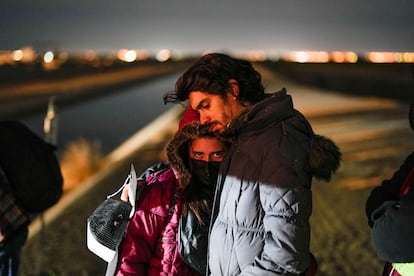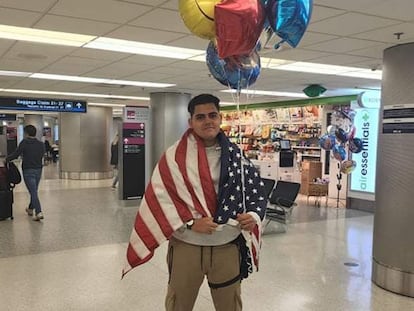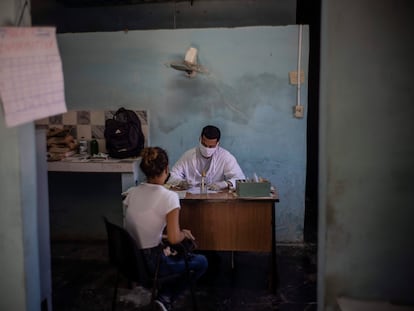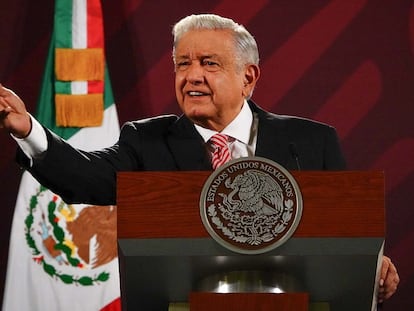More than 50,000 Cubans have arrived in the US on humanitarian parole so far this year
The Biden administration’s program allows migrants to legally enter the country if they have, among other requirements, a sponsor. The island is experiencing the largest exodus since the Cuban Revolution

On the morning of September 22, Delvis Alejandro Paz, 23, boarded an American Airlines plane from Havana Airport and in just 40 minutes, he landed at Miami International Airport. A few days later, he shared a photo on Facebook of his first haircut in the United States and sent a message of hope to those seeking to be accepted, like him, into the humanitarian parole program for Cubans: “People, don’t be discouraged,” he wrote. “I wish you all good luck and you can reach this great country.”
This week, the United States Department of Customs and Border Protection (CBP) announced that a total of 52,053 Cubans had been authorized to travel legally to the country through the humanitarian parole program launched by the Biden administration in January. The program was created in a bid to stop illegal migration across the southern border with Mexico.
More than 300,000 Cubans have arrived in the United States in the last two years, fleeing the current economic crisis in Cuba. This is the biggest exodus since the triumph of the Cuban Revolution in 1959, surpassing the 1980 Mariel boatlift (125,000), the 1994 Cuban rafter crisis (34.00) and the 1965 Camarioca boatlift.

So far, 50,185 Cubans have arrived in the United States thanks to the parole program, which is also available to nationals of Haiti, Nicaragua, and Venezuela. It was also recently extended to Ecuadorians. According to CBP statistics, more than 240,000 people of these four nationalities had been accepted into the program as of the end of September. The list was led by Haiti (96,445) and Venezuela (73,092), with Cuba (50,185) coming in ahead of Nicaragua (44,298).
Parole requirements
The program allows migrants legal entry into the U.S. and the possibility of obtaining work permits, provided they have a sponsor who can financially support them in U.S. territory and they meet the requirements for legal entry. Applicants must apply via the I-134A form.
Although humanitarian parole has allowed many Cubans to avoid the dangerous and very expensive journeys through Central America, or crossing by sea in precarious boats, it is also true that since its inception it has faced criticism. Chief among these is that the program is disorganized, with long waiting times, and often leads to the separation of families, including children.
Cuban Kenia Nápoles Martínez, 39, arrived in Miami on September 29 after a long wait and the fear of not knowing when she would see her husband again. On March 30, four people in her family were granted humanitarian parole, but their eight-month-old daughter was left out. After several days of not knowing what to do, it was decided that Martínez’s husband would go to the United States, while she remained in Cuba to care for their daughter.
Fortunately, Martínez was able to leave the country with her daughter after just over six months, but there are still many families who remain separated due to the failures in the process. The program is overseen by U.S. Citizenship and Immigration Services (USCIS), which can approve no more than 30,000 arrivals each month. “The program has been a blessing for many families, even for me, who had no other way to get here,” says Nápoles, who now resides in Miami Gardens, in southern Florida. “But the issue of family separation is a flaw in the program that must be resolved.”
Yuneisis Nova, 40, was in a similar situation for seven months. After her application was approved in February, she had to wait for the approval for her 11-year-old daughter, which was not confirmed until May. She now lives in Orlando, central Florida, and despite the uncertainty of the months in Cuba, she is grateful for the program. “[Without the program] I could only have come if I crossed the border,” she says. “Being reunited again with my husband and son who were already here has been a balm, it’s brought peace of mind to our lives.”
Undersecretary of Homeland Security Blas Núñez-Neto told the U.S. TV station América TeVé that the United States will consider all parole requests and asked applicants for patience, given the program’s high demand and the large number of applications they receive every month. The latest report from U.S. authorities did not specify how many requests they had received so far. But according to data accessed by the CBS network, last year, more than 1.5 million requests had been filed by the end of April.
The parole program is opposed by 20 Republican states in the United States, which filed a lawsuit against the Biden administration calling for it to be eliminated. According to the lawsuit, “the parole program established by the Department [of Homeland Security] fails each of the law’s three limiting factors. It is not case-by-case, is not for urgent humanitarian reasons, and advances no significant public benefit.”
However, it is still uncertain what direction the program will take. So far, it continues to help many Cubans enter the U.S. It provides a legal way for them to emigrate, in addition to other pathways available to Cubans, such as the immigrant visa, which requires that a family member in the United States make a claim, and the Family Reunification Program (CRFP), which since 2007 has allowed eligible U.S. citizens and legal permanent residents to apply for an entry permit for their family members in Cuba.
Sign up for our weekly newsletter to get more English-language news coverage from EL PAÍS USA Edition
Tu suscripción se está usando en otro dispositivo
¿Quieres añadir otro usuario a tu suscripción?
Si continúas leyendo en este dispositivo, no se podrá leer en el otro.
FlechaTu suscripción se está usando en otro dispositivo y solo puedes acceder a EL PAÍS desde un dispositivo a la vez.
Si quieres compartir tu cuenta, cambia tu suscripción a la modalidad Premium, así podrás añadir otro usuario. Cada uno accederá con su propia cuenta de email, lo que os permitirá personalizar vuestra experiencia en EL PAÍS.
¿Tienes una suscripción de empresa? Accede aquí para contratar más cuentas.
En el caso de no saber quién está usando tu cuenta, te recomendamos cambiar tu contraseña aquí.
Si decides continuar compartiendo tu cuenta, este mensaje se mostrará en tu dispositivo y en el de la otra persona que está usando tu cuenta de forma indefinida, afectando a tu experiencia de lectura. Puedes consultar aquí los términos y condiciones de la suscripción digital.
More information
Archived In
Últimas noticias
Maduro pleads not guilty before the federal court in New York: ‘I am still the president of Venezuela’
A new test can detect Alzheimer’s from a finger prick
UN team enters Sudanese city of El Fasher after paramilitary massacre: ‘It’s like a ghost town’
A recipe for resistance: Indigenous peoples politicize their struggles from the kitchen
Most viewed
- Gilles Lipovetsky: ‘If you want to live better and fall in love, take Prozac, don’t look to philosophy’
- Alain Aspect, Nobel laureate in physics: ‘Einstein was so smart that he would have had to recognize quantum entanglement’
- Alvin Hellerstein, a 92-year-old judge appointed by Bill Clinton, to preside over Maduro’s trial in New York
- Why oil has been at the center of Venezuela-US conflicts for decades
- Maduro’s downfall puts China’s relationship with Venezuela to the test










































